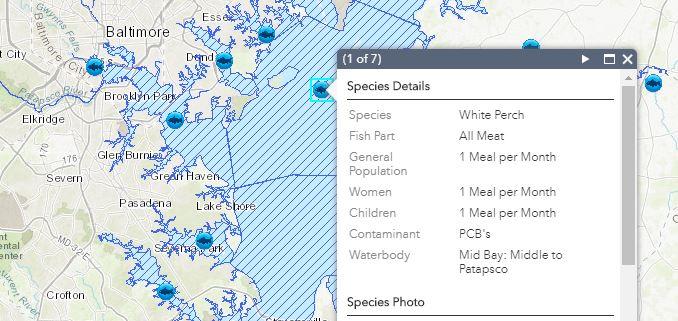The Maryland Department of the Environment (MDE) has announced the development of an interactive map that provides modernized, user-friendly information on fish consumption advisories. It is one of the only “clickable” maps for fish consumption advisories in the nation. A consumption advisory is a recommendation to limit or avoid eating certain species of fish caught from specific bodies of water due to environmental factors.

This resource will allow anglers to see what advisories are in effect in specific waterways by accessing links and replaces a static chart of advisories with an interactive feature that can be opened on web browsers. The web page is optimized for mobile devices, with a widget that allows users to zoom to their exact location on the map with the press of a button.
“Our new, interactive fish consumption advisory map underscores the Hogan administration’s focus on customer service and environmental quality,” said Maryland Environment secretary Ben Grumbles. “We encourage anglers to take advantage of the new map and the health-based meal recommendations for fish and crabs to make smart decisions.” “Along with our ongoing efforts to better inform anglers of optimal conditions for making their best catch, this important tool will keep fishing in Maryland safe and enjoyable for everyone,” Maryland Natural Resources secretary Mark Belton said. “We welcome every opportunity to use sound science and accessible technology to benefit our residents and visitors and enhance their favorite recreational activities.”
The new map includes layers of science-based information, with interactive pop-up windows, to help anglers make healthy choices. It includes the latest MDE meal-based fish consumption advisories, with some new advisories that are more specific for a species and the related body of water. It also includes specific information on meal advisories when eating striped bass with the removal of dark meat and belly fat, where contaminants tend to concentrate.
Fish Consumption Advisories
Fish can be an important part of a healthy diet. They are a good source of high-quality protein and nutrients, are low in saturated fat, and are high in helpful omega fatty acids. A well-balanced diet that includes a variety of fish can contribute to a child’s proper growth and development. However, fish accumulate contaminants that can be harmful to human health.
Fish from locations across Maryland are tested for two contaminants: methylmercury and polychlorinated biphenyls (PCBs). Both contaminants are thought to pose risks to developing brains, and PCBs are suspected to cause cancer in humans. The test results are used in a mathematical equation that factors in health risks posed by these contaminants and tells MDE how many meals per month should be recommended for a given species in a particular body of water. MDE also works to reduce these contaminants, through aggressive air pollution control programs that have significantly reduced mercury emissions and oversight of cleanups to remove PCBs from soils and sediment.
Fish consumption advisories apply to recreationally caught fish, and not fish bought at a restaurant, seafood market, or grocery store. The advisories protect public health, and the department encourages anglers to be aware of the advisories and to follow the recommendations. MDE provides advisories for 24 species, including the blue crab, and advisories for various species in 87 distinct areas of water. The U.S. Environmental Protection Agency and the U.S. Food and Drug Administration issue advice about eating commercially caught fish.
Updated Data
MDE’s fish consumption advisories contain 82 new advisories based on new data. They include 37 areas where advisories allow for more meals per month, and 21 areas where recommended meals per month for a species declined. There is not sufficient data to explain the cause of changes in any particular location. PCBs have been banned in the United States since 1979, but once they are in our environment they take a long time to break down.
The advisories based on new data include one that sets no limits for the general public and women of childbearing age for any size striped bass with the removal of dark meat and belly fat. The new advisory includes recommended limits for those fish for children age 6 and under. The striped bass, also known as rockfish, is the iconic species of Maryland sport fishing. The statewide advisory for striped bass with dark meat and belly fat has not changed, with one exception: a new advisory for fish less than 28 inches in size caught in the upper Patapsco River, Middle Branch. Striped bass from this area were previously included in a recommendation for a broader area, the Chesapeake Bay and its tributaries. The new recommended limits for the Middle Branch – two meals per month for the general public and women of childbearing age and one meal per month for children – protect public health by providing more refined recommendations based on the specific body of water. Fish consumption advisories for the blue crab remain unchanged. Crabs are considered sustainable seafood by the Monterey Bay Aquarium Seafood Watch program.